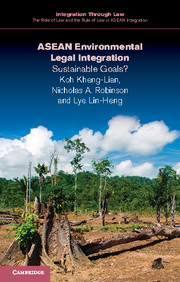
ASEAN Environmental Legal Integration: Sustainable Goals?
While the environmental performance of most ASEAN member states is above the world average, ASEAN nations will continue to face growing environmental challenges due to pressures exerted on them such as population growth, urbanisation and industrialisation. The authors of this book look at how the member states of ASEAN employ law as a means of regional integration within the context of environmental conservation. While the goal of new laws is to implement sustainable development, it continues to be an ongoing adaptive process, since clear and immediate answers to environmental challenges are rarely available. Readers of this book will gain a clear idea of the evolving cooperation for sustainability within ASEAN at regional and global levels, and the areas of focus for the future. The book will be of interest to policy and decision makers, as well as environmental organisations and academics in the field.
This book gives a clear overview of current ASEAN environmental law and how it may develop in the future, situates ASEAN environmental law in a wider political and economic context at both a regional and global level, and presents a clear analysis of the complexities associated with creating and managing environmental law in today’s constantly changing world.
About the ASEAN Integration Through Law book series
Published by Cambridge University Press, this book series evaluates ASEAN’s community-building process and issues at the forefront of ASEAN law and policy. The series covers six themes: the general architecture and aspirations of ASEAN, the governance and management of ASEAN, the legal regimes in ASEAN, the ASEAN Economic Community, ASEAN and the world, and the substantive laws of ASEAN. Click here for the executive summaries of the books in this series.

